Albert Bates is regional secretary for the Americas of the Global Ecovillage Network. He is also the principal founder of the Institute for Appropriate Technology in Tennessee, where he has taught sustainable design, natural building, agriculture, and technology.

Monday, 4 Dec 2000
UNGUIA, Colombia
The fruit hanging from the trees here, which looks like Idaho’s biggest baking potatoes, is zapote (Pachira acuatica), which is called chila blanca in Salvador, pumpunjuche in Honduras, and castana in Cuba. Here at Concisa’s cochina in Unguia, with horses tied to the hitching post on the dirt street in front, Leon makes zapote into first-rate milk shakes, practically a whole meal. He does equally well with cantaroon, lolo, borraho, passion fruit, or guayava, which you can get con leche or con aqua. We have been eating here every day, and Concisa, whose speciality is deep-fried fish, is doing her best to accommodate the vegetarians in our group, here in Unguia to teach “permacultura, ecoconstruccion, y tecnologia apropiada.”

Unguia street traffic.
Photo: © Institute for Appropriate Technology.
I have been living as a sort of voluntary peasant for the past 30 years in a rural intentional community in Tennessee . A lawyer by training, I used to run an environmental law project called the Natural Rights Center, but after writing a book on global warming in 1990, I found that my priorities had changed. Now, the best strategy that I can imagine to wean the world from its carbon habit is lifestyle change. My travelling companion, Alejandra Liora Adler, and I are both on the board of the Institute for Appropriate Technology and active in the Global Ecovillage Network. Our work takes us to communities that are seriously trying to tackle this “sustainability” issue in practical ways. We draw upon the experience of similar efforts all over the world and provide training classes, experienced consultants, and opportunities to network.
Liora is a kibbutz-born Colombian whose home is in Mexico’s oldest ecovillage, Huehuecoyotl. For the past few years she has been travelling with the Rainbow Peace Caravan as it wends its way through the Americas, performing street theater with an environmental slant. The Caravan is our network’s reconnaissance patrol, tracking down rumors of ecological experiments in the farthest reaches and letting them know they are not alone. Worldwide, the Global Ecovillage Network has documented more than 15,000 villages that are doing this kind of redevelopment work.

Schoolchildren under the watchful eyes of the Colombian army.
Photo: © Institute for Appropriate Technology.
The Colombian military, apparently worried for our safety, garrisoned a regiment of the armed forces under the command of a two-star, Tenete Nelson Enrique Chacon; now, you can’t sneeze in this town without dampening the collar of a soldier. Nelson enrolled in our course, but I suspect it is to keep an eye on us, because he is not taking notes or understanding the material. Not to be outdone, the National Police also assigned a Lt. Hernandez. In contrast, he is very studious, because the local Chief of Police has instructed him to teach the rest of the barracks everything he learns after the course is done.
Today, we did a cob dance with the commanding officer and the lieutenant, their M-16s leaning against coconut palms, stomping clay on a big tarp in bare feet and tossing cobs, with several dozen schoolkids gawking, pointing, and giggling at these guys in uniforms getting all muddy. Most of the world’s population lives in earthen buildings, but mud is usually held in low regard, and poor people want to get into something made of cinderblock as soon as they can. Personally, I have never liked the feel of cement buildings (maybe because I went to elementary school in them!) — they deaden sounds and always feel cold to me. We teach people to build more elegantly with basic materials like cob, rammed earth, straw bale, and adobe, using the inherent sculptural qualities to make elegant buildings that even wealthly people would envy.
This is my third course since I arrived in Colombia a couple weeks ago. Liora has been here for some months making all the arrangements. The people taking the class are a mix of trainers from universities and local agricultural agencies, peace activists, and people assisting with programs for refugees. The war in Colombia has resulted in huge numbers of displaced persons — as much as 20 percent of the population of this town of 5,000.
The courses are part of a strategy we have cooked up to help us pay for our meeting that starts later this week. The Ecovillage Network of the Americas (ENA) is now barely two years old, and already it has eight regional offices, each of which will send a representative to the meeting. Some of the regions (and most experimental ecovillages) are financially challenged and air travel can be prohibitive, so our plan has been to run these courses with a mix of paying and free participants and to use that income to bring our council representatives to Colombia.
The school where we are meeting was selected because it has one room with an air conditioner. After an hour, though, the diesel fuel ran out at the town’s power station, so we started to bake. We removed ourselves to a thatch-roofed gazebo by the basketball court. We took a walk around at lunchtime and decided that the first afternoon should be spent in a design exercise involving the school. We broke up the class into four groups and had them look for water, waste, people, and pollution vectors, map them, and come back for evaluation. This turned out to be a really good exercise.
The school’s water comes from a well. One well went bad and was abandoned, an open malaria generator 20 feet from the classrooms. A short distance away is the new well, cement cased but also open, and between the two is the waste pile, rotting coconuts and banana peels, half-burnt plastic bags, old lead batteries, and scrap chemicals. Over 100 inches of rain per year ensures that some of this will eventually soak into the wells. Pigs, chickens, and cows wander the spaces between classrooms, fertilizing the grass and drawing those wonderful little bacteria buses, the flies. Asbestos shingles crumble from the roofs, and where the roofs have failed, the cement classrooms have been abandoned. The toilets are all stopped up. The septic tank has probably never been emptied and overflows when it rains. There is no cafeteria, so vendors peddle junk food by the gate. Barbed wire separates the schoolyard from cattle ranches on three sides. Last year, 20 poisonous snakes were caught in the high grass that grows up to the walkways between classrooms.
We were invited to Unguia because the former mayor, who is now an evangelist for sustainable development, wants to make the town over as an ecovillage. It is
a daunting task, but hey — you have to start somewhere. And actually, these people already have the most vital ingredient — unbridled enthusiasm. The 30 of us spent the afternoon thinking about how we could redesign the school in ways that would teach the children the basic elements of sustainability. And then these children would provide the impetus to redesign Unguia, because as they say, it takes a child to raise a village.
Tuesday, 5 Dec 2000
GILGAL, Colombia
Today, Liora and I enlisted some local motorcycle riders to take us on an excursion to Gilgal, 30 clicks south of Unguia. The track we followed is paved mainly with 10-pound river stones and quite rough and narrow in places. It is undoubtedly much worse when the rains come in earnest. The dirt bikes are small and, at one point, we had to haul them across a river chasm in a metal cage rigged as a bosun’s chair, one bike at a time.
Gilgal, a town of 800, has more than 300 displaced persons. We visited the house of one of our course participants, a teacher at the local school here. The house was pretty standard cinderblock and lamina, and he has hogs, chickens, and fruit trees in the backyard — completely unremarkable for rural South America. Just as I began to wonder why we came, he took us to the Gilgal school and it became crystal clear.
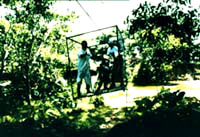
Crossing the river with a motorbike.
Photo: © Institute for Appropriate Technology.
The Gilgal school consists of a half-dozen rondellas — called kiosks — poured-cement-frame gazebos with thatched roofs and painted rainbow colors, each with a blackboard, arranged in a 100-meter circle around a central, larger Aula Central. Each of the smaller rooms serves as an open-aired classroom for a single grade. Aula Central contains the kitchen and cafeteria, library, faculty offices, art room, and science room. The spaces between kiosks are an edible landscape of indigenous fruit trees of Colombia, with both common and Latin names displayed on each tree. Commodes are well-tended, two-compartment, dry-compost toilets, swaled to arrest rainwater infusion at their base. Between classrooms are raised vegetable beds mulched with palm leaves, agroforestry plots, fruit and leaf drying, and ponds for fish farming.
There are 124 students in the Gilgal school. Parents pay 2,000 pesos (one dollar) per month, about 20,000 pesos per year (10 dollars). The school was financed by the local farmers’ cooperative, but is governed by the children’s Systema Asembleario. There is a bulletin board in each kiosk with three pages — one each for criticisms, proposals, and commendations. At the weekly assemblies, student notations are read and discussed, and action is taken by vote of each grade. Commendations are awarded, proposals debated, and punishments meted by the student assemblies.
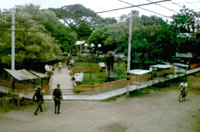
Troops keeping an eye on the area.
Photo: © Institute for Appropriate Technology.
One case we listened to was that of a boy who cut down a young fruit tree. He was criticized, and when the matter came up before his class assembly, he said in his defense only that he had come to school angry at his father for beating his mother and had taken out his anger on the tree. His classmates decided that, while it was good for him to get rid of his anger, he would have to plant two replacement trees and water and care for them until they were well-established.
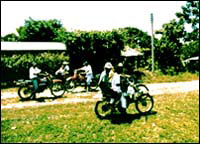
Our valiant steeds.
Photo: © Institute for Appropriate Technology.
When we visited the Las Tribus Co-op that started all these wonders, we were saddened to learn that it was going to close because the paramilitaries considered it too communist. Founded in 1976 by Padre Jose Francisco Ibañaz Artiga, a Claretano missionery, Las Tribus created a community store, encouraged home organic food gardens, designed composting toilets, dug many wells, trained people in home water-storage systems, and planted demonstration hectares of intercropped rice, corn, beans, and sugarcane. For 20 years, Las Tribus gave meaning to sustainable agriculture in rural Colombia. Then the violence found Padre Jose in 1986, at 33-years-old, and it claimed Las Tribus soon after.
The Gilgal health center was built with money from Padre Jose’s family in Spain after his death. The Gilgal school is still kept up, but without the cooperative, it has fallen onto hard times. The teachers have not been paid in three months.
We headed back on the road to Unguia before darkness made travel unsafe for civilians. I straddled the backseat of the dirt bike behind a Colombian driver who was probably already a little too large for the bike. When he chose to change from the right stone rut to the left stone rut at 40 kph, gravel ground across my bare knees and the hot muffler was held by the weight of the horizontal motorcycle against my sliding right ankle as we bounced from stone to stone. You can’t have a 20-meter event horizon at 40 kph and expect that your odds of recovery will be in the plus column. He freed my feet from under himself and the bike and we straightened the handlebars, dabbed at my bleeding knees, and got going again, only to go off the road a second time five clicks later. I told him not to hurry, but he was worried about the Martians and the Africans, as the paramilitaries and the guerrillas are known in these parts. Around sunset, they rise from their crypts and foray in search of fresh blood, especially each other’s.
Wednesday, 6 Dec 2000
RESERVA INTEGRAL SASARDI, Colombia
At 6 a.m., our group assembled in the Unguia Square and trucked over to the waiting panga boat for a trip across the bay to the corner of the Choco peninsula that reaches up like a thumb grip on the Isthmus of Panama. In Turbo, we stopped to pick up the remainder of the Ecovillage Network of the Americas council, which had arrived from Medellin that morning.
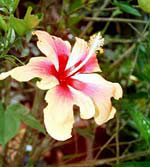
A rainforest flower.
Photo: © Institute for Appropriate Technology.
Most of the way across the Bay of Uraba we found ourselves in brown water, laden with soils of the banana plantations and cattle ranches. But, as the Darien coast loomed up on the horizon, the water turned a turquoise blue, bottle-nosed dolphins formed a screening convoy, and we were in the outflows of the clear rivers of one of the great biological treasures of the world. This is the home of 35 nature preserves and is one of the deepest biodiversity centers in this hemisphere.
This coast was first glimpsed by Rodrigo de Bastidas, part of the Oojeda and Balboa flotilla of 1501. The man for whom Colombia is named skirted this coast on his 4th Expedition in 1502. Darien takes its name from Santa Maria la Antigua del Darien, a colony established by Pizzaro in 1510, the first European settlement on the continent. The ruins of its pier are visible just below the water here.
Colombia, with a territory as large as two Spains or four Italys, contains 10 percent of all the world’s different creatures. It has 1,700 species of birds and 540 species of frogs. Indigenous groups are so varied and numerous that it is difficult to name them — 84 different ethnic groups speak around 60 languages, the majority of which have intact ancestral territories, political organizations, and economic systems.
On
e of the most singular regions is the Colombian Darien, which is pantry to the world for new medicines, makes a substantial contribution to oxygen production and climate regulation, and serves as refuge to its unique tropical megabiodiversity because it is at the locus of interchange for flora and the fauna of both American continents — a biological concentrator that recharges during ice ages and releases only very slowly as the earth warms. It is one of the last tropical humid forests in contact with the sea, with countless plant species and animals that science has not yet classified.
After two hours in the Caribbean, we entered the Bahia Trigana, at the southeast corner of the Isthmus of Panama, and landed at Playa Trigana, a small tourist beach. There was no dock, so we had to wade ashore. After a leisurely swim in the bay, we organized the luggage and loaded it onto two pack mules, which Claudio, our host, arranged to have waiting for us. We ate corn arepas at a beachside stand and talked to Christina, the proprietor. She opened this stand in 1991 and began cooking lunches for the dozen or so people who live along the beach and the (very) occasional tourist.
After lunch, we headed up the trail to the Reserva Sasardi, a trek of unsurpassed beauty. Overhead were a family of Capuchin monkeys, a perezozo (sloth) with her baby, and the chatter of loros (parrots). Sasardi is taken from a Kuna Indian word meaning “clear water.” We followed the stream and its rocks became our path. The mule handler left on a different, longer route around, and we clambered up waterfalls, one after another, for most of an hour.

Capuchin monkey see, Capuchin monkey do.
Photo: © Institute for Appropriate Technology.
At one brief trail stop, we rested under a Seba amarilla, a tree that drops fruits the size of pumpkin squash, which lie on the ground for a few weeks and then explode like land mines, sending shrapnel of seeds over a 100-square-meter area. What remains behind is not a crater, but a huge, beautiful, yellow flower.
At 280 meters above sea level, we broke out into a clearing and arrived at Fundacion Darien, a cluster of thatched houses on the fingers of a steep ridge. The community central kitchen, gardens, laundry house, utility sheds, trade shop, offices, and several homes are all on one central finger, which has been partially cleared and cultivated with low-growing bananas, bamboos, ornamentals, and medicinals. Here are aguacate, mango, pomo roga, mamobcillo, algarrosa, cacao, totumo, papaya, achiote, avocado, plantain, and yucca. Pina, limoncillo, batata, frijol, aji, and tomate flesh out the open areas.
As we sipped fruit juice, little black-faced monkeys ventured closer and their salt-and-pepper saddles and white crown patches told us they are Geoffroy’s Tamarin (Saguinus oedipus Geoffroy). These little guys have been exterminated throughout much of the Isthmus. They prefer second-growth forests, but that is where they are most vulnerable. Strictly diurnal, they feed twice each day: 60 percent fruit, 30 percent insects, 10 percent green plants. They stay in monogamous pairs, one pair to a troupe, and the rest are generally their offspring, although the younger ones sometimes switch troupes when they converge to feed in the trees.
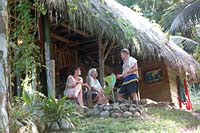
Relaxing at Fundacion Darien.
Photo: © Institute for Appropriate Technology.
Tomorrow morning, we start our council meetings, so tonight we are all ready to retire early, sleeping in mosquito netting strung from a 10-foot wide dream-catcher, which hangs on the second floor of our palm-thatched dormitory.
En todo caso solo puede ser hallada por una maga:
La poesia …
Esa princesa esplendorosa que ha resistido
La verez del tiempo,
El delirio de las hecatombes,
La persecucion de los tiranos,
Y el rigor de la belleza,
He aqui la poesia que es milagro
… “Y milagro es lo que hace falta
Para que no no devoremos en esta comilona agria.”
In any case it could only be written by a magician:
The poetry…
The splendid princess that has resisted
The old age of time,
The delirium of the times,
The persecution of tyrants,
And the rigors of such beauty,
Here it is, the poetry which is miracle
… “And the miracle which is missing
In order for us to not devour each other in our anxious hunger.”
— Jorge David, Medellin biologist, on an early visit to Reserva Sasardi.
Thursday, 7 Dec 2000
RESERVA INTEGRAL SASARDI, Colombia
Today, a local hummingbird, the white-bearded hermit (Phaethornis hispidis), visited our council meeting. While Jeff outlined the Living Routes initiatives, it grazed the red flowers Claudio planted in raised beds at the entrance to our gathering space.
At lunch, we finished the last of the really hot salsa. It was in a half-pint mustard squeeze bottle, and the active ingredient was a tiny red berry the size of a wheat kernel, aji pajarito (Capsicum baccatum). It was first observed by Europeans in the 16th century and was then in widespread use throughout the West Indies. The Indians of Vichada, out in the llanos to our southeast, prepare an aphrodisiac drug called pequi with aji pajarito. We are going to miss this drug. The mild salsa that remains takes 20 times more to confer the same heat, with a fraction of the flavor.
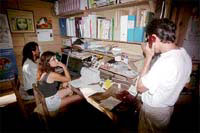
La oficina.
Photo: © Institute for Appropriate Technology.
The other night, we were exchanging stories of insects we had eaten, and Liora stole the trophy with her tale of fat-bellied termites used as (extremely) hot sauce by some tribe in the Gran Sabana in Venezuela. She said after eating one she lay on her back in her mosquito net for half the night in an acid trip of swirling colors and Ghosts of Chanukahs Past. We were all impressed, even Don Orlando, who spoons aji like it was vinaigrette.
Email prods its nose under our tent like a nasty scorpion. Two photovoltaic panels wring out enough sunlight for both the radiophone and the laptops. Liora is busy confirming flights and making other travel arrangements for our departures. We have our iBook wired up, and it draws a steady flow of comments and questions from other parts of the network unable to attend the meeting.

Orlando, Kailash, Linda, and the iBook.
Photo: © Institute for Appropriate Technology.
An unusual daytime rain came today, the second in a row, but we hardly noticed, cocooned in our business. If we weren’t six degrees from the equator, it could be snowing outside and we wouldn’t notice. Still, if we stayed long enough, jungle consciousness would eventually claim even the most cable-ready. Here are roots that bleed red sap when cut, ferns that close when touched, and vines that tack slowly to human movements nearby. The insularity of our cultural addictions might be insulting to this forest, but it doesn’t really care. The night belongs to other species, and they are serenely confident, knowing that we ignore them at our peril.
Rain lingered through the morning, but in the afternoon, Claudio led another hike through the primary forest. We were followed by the white-faced monkeys who are after fruit in the totumo tree (Crescentia acumina
ta). Claudio says when he cut the two large tamboleros beside his house the monkeys screamed at him, because the trees were the shortest route to the totumo and now they have to go a long way around to avoid the dangers of the ground. He said when they screamed and pounded he felt very bad.
At a small pool on a side stream, a crowned woodnymph (Thalurania columbiana) bathed until our approach interrupted her; when we had passed, she returned to finish her bath in peace. At two points on our walk, we encountered quetzals: first, a female white-tailed trogon (Trogon ciridis), large, with a bluish bill, blue eye-ring, and white undertail; later, a female blue-tailed trogon (Trogon camptus) with white eyes and blue rump. There are 12 varieties of quetzal in Colombia and, although none are as impressive as their Guatemalan or Mexican cousins with long peacock tailfeathers, they are, nonetheless, large and noble birds.
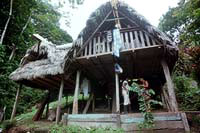
Little house in the rainforest.
Photo: © Institute for Appropriate Technology.
At dusk, a large bat circled the forest edge outside our enclosure, and after taking a full sonar recon, swept the room of gnats so fast that almost none of the people in the room were aware of him. I didn’t have any idea what he looked like. He was a stealth bat. But then, as he scanned his route into the kiosk with some inverted loops, I noticed his iridescent blue wings. I suspect this makes him Myotis albescens, because that bat’s dorsal hairs are black at the base and white at the tip, making it look frosted when still and iridescent in movement, reflecting the blue sky as it performs its daring low-altitude stunts.
What will it take to arrest global warming? In the final analysis, less people and more trees. For there to be less people, we need to raise the standard of living of the world’s poor, and from that heightened security, fertility rates can gradually decline. Saving forests while raising living standards is a complicated affair, because in many parts of the world — and Colombia is a good example — forests are falling to make room for cattle ranches, fruit or coffee plantations, and human settlement. Trees are turned into charcoal to run steel mills to make sport utility vehicles.
So when we speak of raising the standard of living, we have to also speak against raising the level of consumerism. What’s needed is better health care, nutrition, clean water, and low-income housing. What’s not needed are energy-expensive gadgets and coal-fired power plants. The ecovillage movement is all about pioneering this middle ground: the simple elegance of good living, but with a more sensitive ecological footprint. It is premised on the uniquely 21st-century notion that appropriate technologies have been developing in isolation for long enough — it is time to bring them together and shift entire human development patterns towards a more holistic vision.
It also has to be fun or nobody is going to want to make the change.
Friday, 8 Dec 2000
RESERVA INTEGRAL SASARDI, Colombia
Most of us crashed early last night, although a few lasted through Enrique’s raw video footage of Bolivia. I was awakened by a sound like the beating of hummingbird wings, but hummingbird wings rise and fall in pitch and this noise was more constant — and besides, it was pitch black. I couldn’t figure it out. An over-the-mountain helicopter? A Trigana chain saw? A nocturnal honey bee? At last it dawned on me as I detected cautious steps on dry leaves. It was the growling of a panther or tigerette, so quiet it hadn’t awakened the dog or disturbed the snores of Julio, whose bed platform is much closer to the prowler’s path. As it moved uphill, it tripped the early warning system of the howler monkeys, whose shrieks rolled everyone over and made the dog bark. Light was still an hour away, so everyone was soon back to sleep — except me. I rose and wandered down to work on my gray-water system, transplanting water plants into the rock filter at first light, pacing the distance to available stream gravel, and gathering tools.
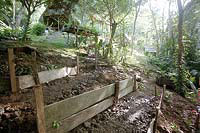
The gray-water beds (under construction).
Photo: © Institute for Appropriate Technology.
Everything clicked in the council meeting today. We slid through a tough agenda with relatively little friction and a dozen significant agreements.
Today’s decisions:
1. Approved the ENA logo
2. Reelected officers
3. Created 9th region
4. Chose the 9th region’s initial council delegate
5. Selected an Ecovillage Contact Office (ECO) in each region
6. Limited access to the council internal list by lurkers
7. Clarified the decision-making process between meetings
8. Approved the regional network autonomy policy
9. Elected a representative to the Global Ecovillage Network (GEN) board
10. Created a timetable for developing our next strategic plan
11. Created a plan for bylaws revision
12. Reported numerous decisions by committees
There was some disappointment with unfulfilled expectations related to the budget and our fund-raising plan. Maybe we should have spent more time in the financial committee meetings. Likewise, the ECO guidelines were presented too unformed and have been sent back to committee. But on the whole, we are satisfied. For a group that has to work in three or four languages, we did all right.
After lunch, I mustered a dozen pairs of hands and started putting golf ball-sized stones into bags at the stream and schlepping them up the hill. If we had twice as many people, we could have formed a bucket brigade, and if we had twice as much time, we might have rigged a cable hoist. As it was, we used the four strongest backs — the Cuban, Roberto; Juan the Colombian; Giovanni the Mexican; and the Venezuelan, Orlando — to make the most climbs carrying sacks of rock 130 meters up the slope to the newly constructed wetland by the dishwashing sink. Within the hour, I shouted, “Finito!,” and we were back up top admiring our work. Giovanni set about reworking the Reserva’s wooden drums — disassembling the broken pieces, sanding the edges, repairing the rawhide strings, and cutting new hides for heads. Others prepared for another trip to Unguia, where they will begin a community conflict and consensus course in three days.
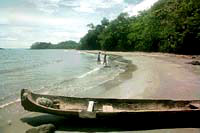
Playa Sardi, one of many pristine beaches.
Photo: © Institute for Appropriate Technology.
A woman who works for the network of National Reserves had a sad story: Sixty of the Natural Reserves, about half, have been closed by the violence in the past few years. The first of the Darien parques has recently fallen the same way — the residents who study the biology and host the visiting scientists have been forced to leave on penalty of death. To the south, repositories of biodiversity have then become battlefields, suffering indiscriminant burning by the guerrillas, aerial bombardment from the army, crop and forest defoliation for narcotrafficantes, and other unthinkable crimes against the very heart of nature. It is Szeberniza or Sarajevo, the peacekeepers withdrawing to leave an utterly dependent refugee safe haven in the hands of killers. The country is not moving toward peace, she said, it is moving toward war as the base of its economy, with impoverished youth taking jobs with whomever can pay, clothe, and feed them. It is ecowar writ large, not in the barren oil fields of Kuwait, but in the deepest sanctuaries of life.
The
precariousness of Sasardi is stark. Paramilitaries control the beaches. Guerrillas control the mountains. The isthmus is a prime transshipment point between the Atlantic and the Pacific coasts, and from the coasts much of Colombia can be reached by sea or by river, which is why it is so strategic for all parties to the war. And there, smack dab in the middle, are the natural reserves — biological treasure chests exposed to the raiders of our future.
Soon I will be back in Tennessee, greeting our new apprentices and preparing our new courses. We go through life collecting people and places we love, and they become our memories. On this trip, I’ve collected the ex-mayor of Unguia, the dockside at Turbo, the beach at Trigana, the black-faced Tamarins of Sasardi, and Leon’s fruit milkshakes in a little open-aired restaurant on a dirt street in a poor, dusty, embattled cowtown in the richest country on earth.

